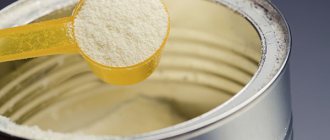23.09.2019 14232 0
Reasons for switching to non-mixture
Basic rules of transition
Which mixture to choose
Mother's milk is a natural source of nutrients for babies, but sometimes breastfeeding is not possible or the amount of mother's milk is low and attempts to improve lactation are not successful. Parents have to decide whether to introduce an adapted formula into the diet. Recommendations for mixed and artificial feeding will help accustom your baby to it without harm to health.
Try to breastfeed your baby for as long as possible
The transition to artificial nutrition is considered metabolic stress (metabolism - metabolism in the body), therefore, if there is at least a minimal amount of milk, you should continue to put the baby to the breast and strive to prolong the breastfeeding process as long as possible.
Sometimes, for one or another serious reason (serious illness of the mother, lack of lactation, etc.), a child may be bottle-fed from the first days of life. But, unfortunately, it often happens that the mother herself, not wanting to breastfeed, easily makes such an important decision. She thinks this is the simplest way out of many problems.
When to stop breastfeeding
Breastfeeding is a completely natural process for any woman. It provides not only nutrition for the baby, but also his emotional contact with his mother. If a woman is healthy, breastfeeding is easy to establish. But there are cases in which a mother has to give up breastfeeding: - when taking certain medications, - during a long stay in hospital and surgical operations, - with infectious diseases, - with diseases of the mammary glands, - due to a long stay, - with prolonged absence of lactation.
If transition is inevitable
It happens that the baby gets worried and screams during or immediately after feeding, and then there is a suspicion of a lack of milk. At the same time, the mother feels emptiness in the mammary glands while the baby is still actively sucking, and the number of wet diapers meanwhile noticeably decreases.
There is no need to immediately suspect the worst - it could just be a lactation crisis that will pass soon. There are many ways to increase the volume of breast milk - if you wish.
But if none of the measures taken gives a positive result and the transition to artificial nutrition is inevitable, then you need to consult a doctor and, together with him, choose one or another formula, based on the characteristics of the baby’s development.
What to buy
- Buy the formula recommended by your pediatrician
.
Buy it at a pharmacy or specialty store. When purchasing, be sure to check the expiration date. Mixtures packaged in metal cans are stored longer than those packaged in plastic or foil bags and boxes. - Buy several bottles
of different sizes and several nipples - so that you have a supply.
Select
pacifiers Many children find it difficult to transition to bottle feeding, so for the first time it is worth purchasing a pacifier that is most suitable for simulating breastfeeding. — Stock up on the necessary accessories
for artificial feeding: a brush for washing bottles, a sterilizer, a device for heating and maintaining the temperature of the mixture. Electrical appliances do not have to be purchased new; they can be purchased secondhand or borrowed from relatives and friends. After all, they are rarely used for more than a year and, as a rule, remain in excellent condition.
What types of mixtures are there?
Modern milk formulas are made from specially processed cow's (less commonly goat's) milk.
In their properties and composition, they are very close to human breast milk and are divided according to the degree of adaptation to it:
- Adapted mixtures are fermented and unleavened, liquid and dry. They contain whey proteins, carbohydrates in the form of lactose, vegetable fats, vitamins and minerals in balanced amounts. Examples of manufacturers of such products: “Agusha”, “Nan”, “Nutrilon-1”, “Tuttelli”, “Frisolak”, “HIPP-1” and many others. etc.
- The second degree of adaptation is mixtures based on casein without the addition of whey proteins. These are “Nestozhen”, “Similak”, “Impress”, “Lactofidus”, “Danone”, etc.;
- Therapeutic mixtures are used for low-weight or premature babies, for babies prone to allergic reactions, suffering from abdominal pain, constipation, regurgitation, and unstable stools. There are strict indications for taking such mixtures and precise schemes for their introduction into the diet. If you start giving them without consulting a doctor, you risk harming your baby.
- Starting from the 7th month, you can use transitional mixtures (the so-called “subsequent formulas”: “Nutrilak 2”, “Gallia 2”, “Nan 6–12”, “Baby 2”, “HIPP 2”, “Enfamil” 2").
In the first month of life, the baby should be prescribed unleavened formulas, since fermented milk formulas can increase regurgitation. A little later, you can combine both, replacing one, two or three feedings with fermented milk mixture.
What to feed
Women's breast milk is ideally suited in its composition to the needs of the child. Therefore, it cannot be fed with whole cow's or even goat's milk. Their composition is very different from human milk and leads not only to digestive problems in the child, but also to problems with growth and development. For artificial feeding of a baby, special adapted formulas
, the composition of which manufacturers try to bring as close as possible to a woman’s breast milk. They usually include whey proteins, casein, lactose, a composition of vegetable oils, as well as minerals and vitamins that meet the needs of the child during certain periods of his development. The specific mixture is selected only by the pediatrician depending on the baby’s health condition. Parents should not independently choose adapted formulas based on their own preferences or financial capabilities and without first obtaining consultation from a specialist.
Introduction of a new mixture into the diet
There are times when a mother decides that it’s time to find a better formula, buys a new product and immediately introduces it into the child’s diet in full. A couple of days later, she learns from a television advertisement about the existence of a new cutting-edge mixture and immediately quickly switches to it.
If in such cases nothing unexpected happened, then the mother was very lucky. But a child’s body can react to such stress with an allergic reaction or stomach upset. And not so much because the new formula did not suit the baby, but simply because it was introduced incorrectly.
The new mixture should be introduced gradually, gradually increasing its volume by reducing the volume of the mixture being replaced. Read the preparation instructions on the package; do not store the diluted mixture in the refrigerator for more than a day.
What not to do
1. Change the formula without the pediatrician’s recommendation in the first three months of the baby’s life. His digestive tract is still very immature at this age, and it takes him a long time to adapt to the new formula. 2. Try to feed the baby as much formula as possible. 3. Combine several different mixtures in feeding without a doctor’s recommendation. 4. Feed the baby formula intended for older children. 5. Refuse to consult a pediatrician if the child does not gain weight, does not want to eat, or has a digestive disorder.
Diet of a child with artificial and mixed feeding
If your baby is on mixed feeding, then the diet remains free. You just need to control the amount of breast milk using control weighing, compensating for the missing volume with the formula. Supplementary feeding is done only after the baby is applied to both breasts.
It is advisable to give it from a spoon so that your baby does not completely refuse to take the breast. If supplementary feeding is large, use a bottle and nipple with small holes.
If your child is bottle-fed, then you need to switch to regular feeding. For the first 6 months of life, it is recommended to take the mixture six to seven times every 3 or 3.5 hours with one 6 or 6.5 hour break.
How to switch to artificial feeding
If, at your own request or for medical reasons, you have to wean your baby from the breast, you need to find out how to switch to artificial feeding. With gradual translation and compliance with the necessary rules, this is not difficult.
Table of contents
|
Formula feeding from birth
The easiest way for a child’s body to adapt to breast milk substitutes is to introduce them to them from the first day. Pay special attention to your food choices.
In this matter, it is better to seek help from a doctor. If possible, the transition should be gradual. In this case, it will take from 5 to 14 days.
How does this happen:
- On the birthday, artificial nutrition takes up half of the norm in each feeding. The other half consists of decoctions of fruits, vegetables or rose hips, and a glucose solution.
- On the second day, the portion is increased. It already makes up 2/3 of the total amount of food.
- If the newborn reacts well to such a diet, already on the 5th day you can completely transfer him to artificial nutrition.
Transfer to artificial feeding from one month to six months
If faced with any difficulties in feeding, the mother can wean the baby from the breast and start feeding him special food at 1 month.
If this happened later, the algorithm will be the same at 2 months, at 3 months, at 4 months, at 5 months. At 6 months, only the nutrition itself will change - mixture No. 1 will give way to formula No. 2, and the first complementary foods will appear.
At any age, the transition should be gradual. If the mother has milk, feeding should begin with it, at the end giving the baby 20-30 ml of artificial nutrition.
For the first time this will be enough. Then you can completely replace one feeding. With each subsequent day, add one feeding with the formula until it completely replaces mother's milk.
If an undesirable reaction occurs during the first feeding, perhaps the body is simply adapting to a new product. If rashes appear after each meal, the mixture needs to be changed.
You may have to do this several times.
Formula feeding rules
To ensure your baby grows strong, follow specific rules:
- To ensure that food is well digested, you need to offer your child additional water.
- Maintain time intervals between meals. They must be at least 3.5 hours during the day and 6 hours at night. It takes longer for the body to absorb an artificial product than to process breast milk.
- If your baby hasn't finished his meal, don't force him to eat. This means that the portion he received is enough for him.
- Do not change the diet if it suits your child. Otherwise, his body will have to adapt again.
- Protect your child from overeating. Excessive amounts of food stretch the stomach, which subsequently leads to weight problems.
- To avoid unnecessary swallowing of air, watch the position of the bottle. The correct position is when the liquid completely fills the nipple.
- When preparing food, strictly follow the instructions and use boiled water no colder or hotter than 37 degrees.
- Food must be fresh. The use of the remaining liquid in the next feeding is prohibited.
- If constipation occurs, increase the amount of water between feedings.
- If you experience rashes, digestive problems, or other undesirable effects, consult your pediatrician.
What are the pros and cons of artificial nutrition?
If the desire to wean your baby is not supported by medical indications, weigh the pros and cons before making a decision.
The advantages of artificial feeding include:
- Mobility. Dad or other family members can prepare the food. Then mom can go to work, do household chores, or just relax.
- Mom's nutrition without restrictions. You no longer have to evaluate risks when choosing products for yourself.
- Sharing of responsibilities. By preparing the formula and feeding the baby, the father will feel how important it is to properly care for the baby.
- Control over the amount of food. The bottle allows you to correctly calculate the dosage, avoiding overeating or undereating.
- Tracking reactions. While breastfeeding, a woman sometimes cannot understand what product in her diet the baby reacted to. If a reaction occurs while eating the mixture, it’s immediately clear what’s going on. It is enough to change it for another.
There are also plenty of disadvantages to this diet:
- Breast milk is healthier than any formula.
- Artificial products do not transmit to the child the immunity passed on from the mother during breastfeeding.
- There is no such close contact with the baby as when feeding with your own milk.
- If you suddenly stop breastfeeding, the mother may develop breast diseases.
- Swallowing large volumes of air.
- Additional expenses.
- Wasting extra time preparing formula and worrying about caring for bottles.
There are more disadvantages, so it is better to switch to milk substitutes only when absolutely necessary.
How to replace breast milk
Manufacturers offer a large selection of different mixtures. This allows you to choose a product even for children with severe allergies.
Useful tips for mothers: MIXED AND ARTIFICIAL FEEDING
Mixtures can be liquid and dry, fresh and fermented milk, adapted and unadapted. Their composition is close to breast milk.
- Dry mixtures are considered the most common. They are affordable and easy to store.
- Liquid milk substitutes are more expensive. They do not need to be cooked, which is very convenient on the street, when traveling, when you urgently need to feed the baby.
- Adapted mixtures are produced with goat or cow milk. It undergoes special processing and is saturated with vitamins and minerals. This product is most similar to breast milk, activates metabolism and is well absorbed.
- From 6 months, children can use a partially adapted product. It is made from casein.
- Non-adapted mixtures are attractive because they are cheap, but are inferior in quality. The protein in their composition does not undergo special processing, so it is poorly absorbed.
- Specialized formulas are produced for premature babies, allergy sufferers and sick children. They are selected only after consultation with a doctor, so as not to aggravate the situation.
- For children with problems with the stomach and intestines, acidophilic mixtures are recommended. They contain lactic acid bacteria.
Doctors categorically do not recommend replacing breast milk with goat or cow milk.
It is better not to give it to children under one year old. A large amount of calcium and phosphorus in its composition can cause various diseases, allergies and problems with the skeletal system.
Choosing a mixture
How easy it will be to transfer a baby to artificial nutrition largely depends on the right product.
- For the youngest (up to a month old), an adapted or highly adapted product is best suited.
- Consider the reaction and preferences of the baby. A toddler and his body may like one food, but not another. In this case, you will have to try several options.
- Study the packaging. There should be no damage to it. The expiration date is the most important thing to read. Also pay attention to what age a particular product is intended for.
Is the mixture suitable?
This is easy to determine. Just pay attention to a few signs:
- If the baby likes the new food, he will eat with pleasure. Otherwise, he will show his dissatisfaction - he will turn away, spit out the bottle, and become capricious.
- Stable weight gain is another sign that the product is suitable. Please note that there is no overkill.
- There should be no frequent regurgitation, skin rashes, or difficulty passing stool.
When switching your baby to artificial food, do not rush. Evaluate all the pros and cons.
If transfer is unavoidable, increase the volume of the formula gradually, giving the child's body the opportunity to adapt.
When choosing food, focus on the baby's needs. If one product doesn't work, try another.
Carefully read the information on the packaging and follow the instructions. Do not give your child under one year of age goat's or cow's milk. This may cause unwanted reactions.
Keep an eye on the volumes!
Hunger or overeating will be bad for your health. With proper translation, the child will quickly adapt and be happy with the new food.
- about the author
- Recent publications
Arina Nagovitsyna
author of the publication (site editor)
JOURNALIST Higher education: Faculty of Journalism and Mass Communications
Arina Nagovitsyna recently published (see all)
- What can a child at 3 months - 09/12/2019
- What a 2 month old baby can do – 09/11/2019
- Which formula to choose when mixed feeding - 09/10/2019
Calculating food volumes
The required amount of nutrition is calculated based on the baby’s physiological need for energy. In the first half of life, this need is 115 kcal/kg. In the second - 110 kcal/kg of the child’s body weight.
To put it simply, the daily amount of food for a baby with normal physical development is:
- Up to 2 months - 1/5 body weight;
- From 2 to 4 months - 1/6 body weight;
- From 4 to 6 months - 1/7 body weight;
- From 6 months to a year - 1/8 of body weight.
The one-time volume of the mixture can be easily calculated based on the daily volume, simply dividing it by the number of feedings.
These volume figures do not include water and juices.
The most important
If breastfeeding is not possible, the child should be transferred to artificial feeding, for which special adapted formulas are intended.
Consult with your pediatrician before you start giving formula to your baby - your doctor will help you choose a specific product and tell you how to feed your baby correctly. Tags:
- Breast-feeding
- Babies
- Artificial feeding
To leave a comment you must be an authorized user
TRANSFER OF A CHILD TO FORMULA | Tags: translate, month, translate, month
From user log Nastasya
17 October 2013, 17:42
Girls, tell me, who switched the child from breastfeeding to artificial (or mixed) feeding, how was the transfer done, how long did it take to completely replace morning, afternoon and evening breastfeeding with formula, what formula was given? The child is 5 months old, we are fully on breastfeeding plus a little complementary feeding, I need to go to work (let the slippers fly at me), that is, I can breastfeed only at night and at night, the option of expressing in advance is not suitable, there is no place and no time to express at work. Yes, and we are gaining very little, at 5 months 6 kg in total, maybe my milk is empty.
Similar posts on the topic “TRANSFERING A CHILD TO FORMULA”
- how to switch a child to formula? I just can’t do it :(((my daughter is stuck to tita and doesn’t want to eat any formula! It’s already a bottle...
- How to switch a child to formula? Please tell me how to switch a child to formula? Women’s affairs have begun, I can’t go without painkillers...
- Tell me how to switch a child to formula? Girls, who switched a child from breast milk to formula. The child is 9 months old, it would be advisable to switch to formula...
www.baby.ru











